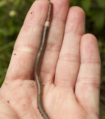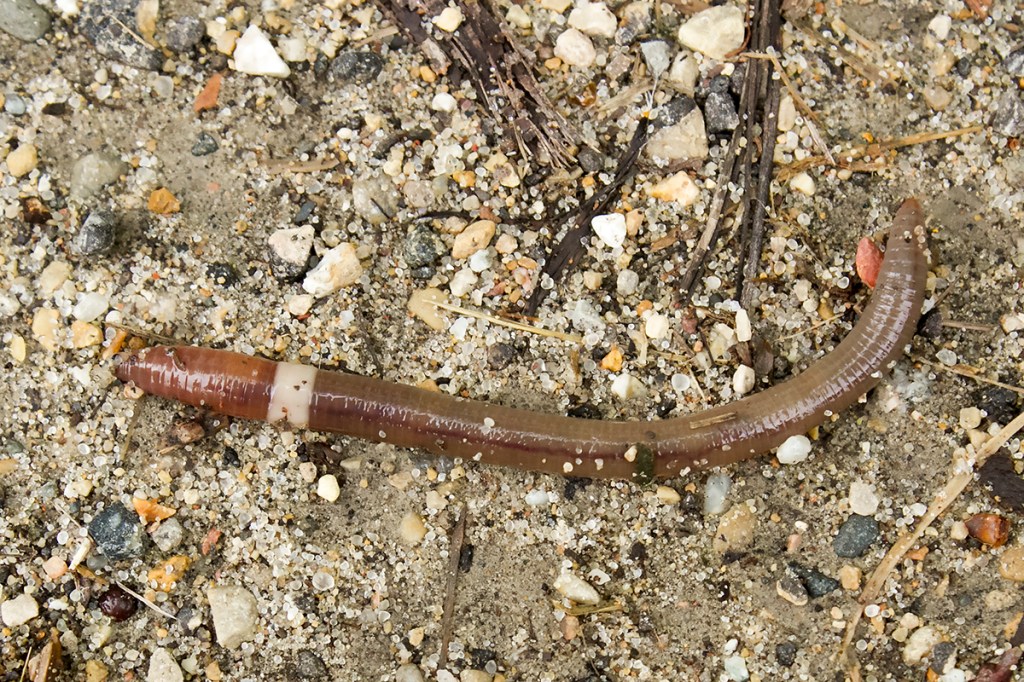Disturb a jumping worm and it’s like a nightcrawler on steroids: It violently writhes on the forest floor, recalling a snake in a bad horror movie. Try to catch it, a piece of its tail will detach in your hand — still wriggling as you hold it.
But put aside the creepy factor: jumping worms may be the next big threat to northern forests.
Jumping worms, consisting of various non-native species from multiple genera, have become established in a number of eastern and southeastern states. In 2013, species from the genus Amynthas were confirmed for the first time in the Upper Midwest, at the University of Wisconsin-Madison Arboretum.
In the forests and prairies of the Upper Midwest, the jumping worm could significantly alter habitats and decrease biodiversity. Why are they so damaging? And is there anything we can do to stop them?
Why Much of What You Know About Earthworms is Wrong
You probably learned about the wonders of earthworms at an early age. They aerate the soil. They help your garden grow. And they catch fish. The humble earthworm is a creature to celebrate.

Overlooked in all this earthworm love is an important fact: in a significant portion of the North American continent, no native earthworms have existed since before the Ice Age. As such, forests and other habitats have evolved without them.
But people love earthworms. They indeed use them by the millions for fishing, and for composting, and to help gardens grow. And so the worms have been spread far and wide. Even areas with native earthworms have largely been taken over by non-native varieties. The common nightcrawler — familiar to anyone who has ever cast a bobber and hook — is a European species.
Earthworms have also spread into the northern habitats where worms have been absent for thousands of years. The hype is true: earthworms cycle through a lot of refuse, and fundamentally change the soil. This may be good in your backyard garden plot, but it’s not in the northern forest.
“Earthworms change the environment to suit their needs,” says Brad Herrick, ecologist and research program program manager at the University of Wisconsin-Madison Arboretum. “When they are introduced, they make a host of physical, chemical and biological changes to the soil environment.”
Essentially, worms turn the forest floor — a complex community of plants, invertebrates and microbes – into a completely different habitat.
The jumping worm, if established in the Upper Midwest, brings new threats. “We think the changes to native habitats will be similar to other earthworms but even more dynamic,” says Herrick.
Spread of the Jumping Worm
You probably think of earthworms as living underground. But the jumping worm actually lives in the topmost layer of the forest floor — amongst the fallen leaves and other material that cover the soil. It eats that fallen organic material. And that’s the problem.
That leaf litter provides essential nutrients to the forest. Trees need long-lasting sources of nutrients. When jumping worms quickly turn leaves into very loose soil (resembling coffee grounds), they deprive trees of essential nutrients.
They thus can inhibit the establishment of tree seedlings. The altered soil is inhospitable to many native plant species. And that soil also disrupts the relationships between fungi and trees.
In short, the jumping worm could have profound effects on the overall forest ecosystem.
As with so many invasive species, they’re adaptable and difficult to stop. They’re parthenogenetic: they can reproduce without fertilization. The introduction of a single individual is enough to launch a jumping worm invasion.
The worms have an annual life cycle. They die in the fall, but leave tiny cocoons that spend the winter in the soil.
And they can be spread readily by human habits. Take their preferred habitat of fallen leaves. At this time of year, many people are raking leaves into a pile and setting them by the road to be picked up or converted into mulch. The worms — or their cocoons — are thus transported to new habitats. Compost and potted plants can also move the worms around.
“Unfortunately at this time, there are no good control measures,” says Herrick. “The important thing now is to the stop the spread. Everyone can help.”
Stop the Jumping Worm
Herrick and other conservationists agree that prevention is the most effective tactic. If you live in the Upper Midwest, and see a writhing, snake-like earthworm in your backyard, report it to your state natural resources department. (In Wisconsin, you can email invasive.species@wi.gov to report sightings).
The Wisconsin Department of Natural Resources also has a handy identification card to help you distinguish the jumping worm from the common nightcrawler.
Wisconsin DNR also suggests examining potted plants and gardening and landscaping materials for the presence of jumping worms. If you are doing landscaping and gardening work, be sure to clean your equipment and clothing to prevent transporting cocoons.
And if you buy compost, only buy from sources that heat the compost at appropriate temperatures and duration to kill pathogens.
The jumping worm is not yet established in much of the northern United States. The time is now to keep it from becoming the next invasive species horror story.




Seed’s produce better without a leaf litter so who cares about another scientist that tell’s the world they are right!!!
Besides notifying the authorities what are you supposed to do to get rid of them?
They’re here in Reno, Nevada
Since they are soft bodied and I am organic gardener I wonder if diatomaceuos earth would work? Also a picture of their cocoons would be nice for identification.
I’m so glad to see your report. When I first discovered these worms the Wisconsin DNR told me they were only big nightcrawlers. Neighbors came to dig them up for fishing and to put in their compost heap. I can only imagine the extent of the damage caused by advice received from this one DNR worker. There is virtually NO SOIL left in my yard – it’s all “coffee ground” soil. Thank you for sending out the truth about this destructive species.
I have noticed very large worms mostly on top of the ground act aggressively nothing like a regular worm.
I live in western WV in town and I have these jumping worms in my compost pile. Always had night crawlers and good earthworm population in the soil around my plants. Now these weirdos are taking over. What to do? Thanks.
Its a little worm, ohe bad ucd it be, i i mean , he needs some where to go, why cant we let him make his home in our forest, theres plenty of it to go around.
Is there a way to break down the castings of the jumping worm to make
The soil fertile?
Can jumping worm cocoons survive Canadian winters?